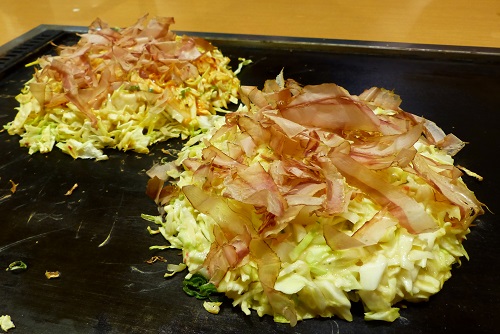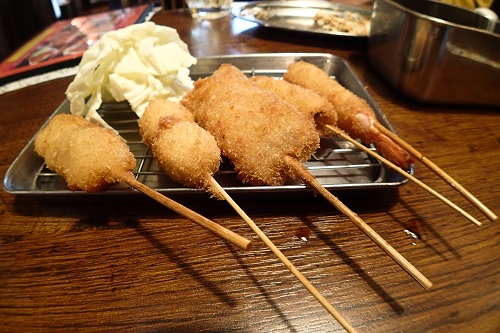Strips of squid blister and curl on the hot plate while tightly packed skewers of chicken sizzle and spit over an open flame. Hungry patrons hunch over piping hot noodle soup, served in disposable bowls. With a blur of chopsticks, they inhale the noodles noisily. Nearby, freshly grilled fish-shaped cakes are nibbled with care lest the custard inside escapes. Forget haute cuisine, this is Osaka, one of the best known foodie destinations in Japan and particularly renowned for unpretentious street food and casual dining.
Takoyaki: Osaka Street Food
We saw the takoyaki master pouring a thick batter into hundreds of small, circular divots on a specially designed hotplate. He dropped a cube of octopus tentacle, complete with suckers, into the middle of each pool. Adding a sprinkling of pickled ginger and spring onion, he then adeptly poked and turned each ball with a cocktail stick. We quickly learned that eating takoyaki fresh from the grill, while tempting, is much like eating a bite-sized ball of molten lava. It's wise to wait a few minutes first. With a crispy shell, soft pulp and a firm chunk of octopus at the centre, the texture of takoyaki is interesting. Most of the flavour however comes from the toppings. This would usually be tangy takoyaki sauce, creamy mayonnaise, powdered seaweed and bonito flakes. Takoyaki is the quintessential Osaka street food, usually found at stalls, particularly around the Dotonbori area.

Takoyaki
Okonomiyaki, Our Favourite Food In Osaka
Okonomiyaki translates as “as you like it pancakes”, which refers to the choice of toppings available. Tsuruhashi Fugetsu is a local chain in Osaka and we ate there a lot. It's popular because they prepare the okonomiyaki for you on the hot plate at your table.
The staff start with a basic batter, with the added secret ingredient of yam. It's mixed with piles of crisp, shredded cabbage and your chosen topping and tipped onto a hot plate. Large transparent flakes of dried bonito are piled on, seeming to wave at you from the grill as they twist and writhe in the heat. Finally, the cook dollops excessive quantities of sweet okonomiyaki sauce and mayonnaise on top. It turns this otherwise healthy dish into a dieter's nightmare. Afterwards, adding your own dusting of aosako powdered seaweed is optional. We did once see an elderly man empty a whole jar of this green dust onto his plate however, completely obscuring the okonomiyaki beneath.

1: Mixing Okonomiyaki

2: Grilling Okonomiyaki

3: Adding Mayo

The Finished Article
The best okonomiyaki at Tsuruhashi Fugetsu is jaga-mochi-chizu. It combines potato with the stringy mozzarella-like texture of rice cakes and some added cheese. For something a little spicier, the pork and kimchi (Korean fermented cabbage) is also a winning combination.
Kushikatsu - The Perfect Beer Snack
Just about anything can be skewered, coated in breadcrumbs and deep fried for kushikatsu. Staple kushikatsu food in Osaka is usually pork, shrimp and vegetables. From the crunchy succulence of lotus root to meaty shiitake mushrooms, there really is kushikatsu to suit every taste. Our particular favourites are boiled quail's eggs and cheese. Nibbling tiny quail's eggs is much easier than tackling a full-sized skewered egg. And the cheese, a rarity in Japan, melts just enough to give that satisfying goo without dribbling out when you bite into it. Eaten hot and dipped in a large, communal vat of sauce, kushikatsu provides the perfect blend of salty sauce and crispy batter making it an ideal beer snack. Just remember the cardinal rule – no double dipping!
Kushikatsu originated in the Shinsekai area of Osaka where working men would stop on their way home to enjoy the cheap, filling skewers of meat. Ninety years later not much has changed. In the evening, lively crowds pack into every kushikatsu restaurant to enjoy post-work skewers and drinks. We have tried frying our own kushikatsu. Restaurants like Kushiya Monogatari offer all you can eat buffet-style kushikatsu where you choose your favourites to fry at your table. Although this is great fun, it never tastes quite as good without the 'master's touch'.

Kushikatsu
Kitsune Udon
It's a firmly established fact in Japanese folklore that abura-age tofu is a fox's favourite food. These wrinkly pouches of deep fried tofu have a sweet bread-like texture and are the key ingredient in kitsune udon, literally fox noodles. The thick, chewy, udon noodles are immersed in a mild fish based stock and topped with this tofu. Spring onions and a thin flower-shaped slice of narutomaki, adorned with a pink spiral design, liven up this otherwise monochrome dish. Most noodle shops in Osaka serve Kitsune udon.
Ask any Osakan and they'll tell you people from this city have a reputation for being funny. We were repeatedly told the story of a comedian who stood outside busy train stations pretending to attack strangers with an imaginary sword. In Tokyo people scurried away, head down, pretending nothing had happened. In Osaka on the other hand, victims played out dramatic deaths in the street, complete with sound effects. For most Osakans, this relaxed, easy-going attitude sums up the difference between the two cities. It's a trait that comes across in the food as well. Osaka does have its fair share of restaurants serving tiny morsels of exquisitely presented delicacies from all over the country. The 'must try' local dishes however, are the casual comfort foods that embody the heart and soul of the city.
